#cambrian echinoderms
Explore tagged Tumblr posts
Text
Fossil Friday: Echinoderms!
Echinoderms belong to the phylum Echinodermata and are usually recognized by their radial or pentamerous symmetry.
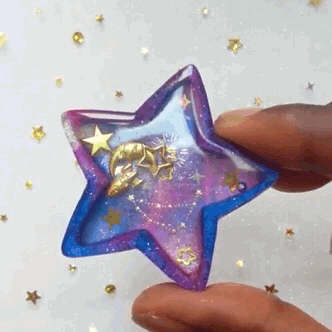
This group includes starfish, brittle stars,

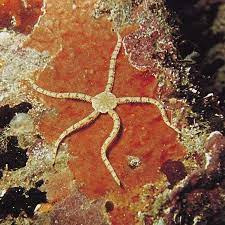
sea urchins, sand dollars,
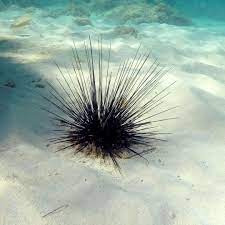
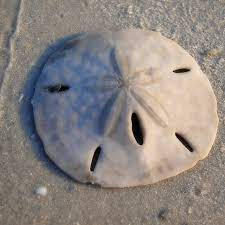
sea cucumbers, sea lilies, and a number of extinct genera.
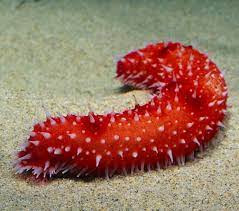
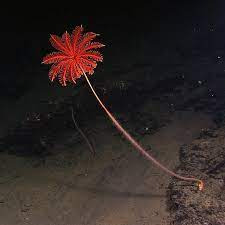
They are found at every ocean depth on the sea floor and are the largest marine-only phylum.
Echinoderms have both ecologic and geologic significance. There are few other groupings so abundant on the deep sea abyssal plains as well as the shallower shelf environments. Most can reproduce asexually when needed and they can regenerate tissues, organs and limbs.
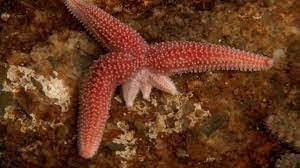
Geologically, their ossified skeletons can provide clues to the paleoenvironment and they are a major contributor to limestone creation and deposition.
The first definitive echinoderms evolved in the earl Cambrian Period during the Cambrian Explosion (with one possibly older than that if it is indeed, an echinoderm). The name echinoderm means "hedgehog skin" in Greek. There are 7,000 extant (living) species and around 13,000 extinct ones. But what did those earliest echinoderms look like? The answer is : not much like modern ones. Shocker, I know.
The oldest possible echinoderm, Arkarua, came from Edicaran-aged rocks (end Precambrian Era) in Australia. It was a small, disk-like fossil with a raised center, radial ridges along the rim and a five-pointed central depression marked with radial lines of five small dots. They ranged from 3-10 mm. Tiny little guys.

Cambrian echinoderms were a little less obvious, more like weird pedicure heel scrubbers. One did look a bit like an early crinoid, and the one in the corner looks a bit like a taser.
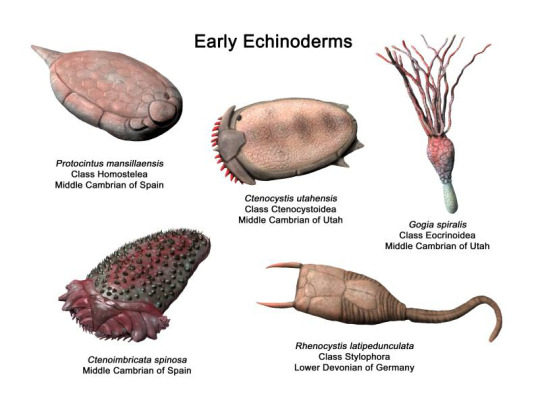
In younger rocks, you'll find things like cystoids, blastoids and crinoids and eventually starfish and other recognizable echinoderms.
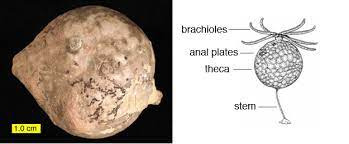
cystoid
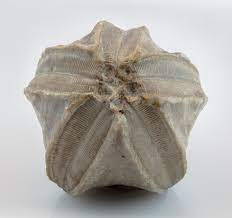

blastoid and crinoid

18 notes
·
View notes
Text
Round 1 - Phylum Echinodermata




(Sources - 1, 2, 3, 4)
Echinodermata is a phylum of animals which are bilaterally symmetrical as larvae but radially symmetrical as adults. It includes starfish, brittle stars, sea urchins, sand dollars, sea cucumbers, and sea lilies.
Echinodermata is the largest marine-only phylum, and echinoderms can be found at every ocean depth from the intertidal zone to the abyssal zone. They make up a large portion of life in the deep sea. They are diverse, with some being sessile (lacking self-locomotion) while others are motile (able to move independently). Many are restricted to crawling slowly across the sea floor, while some can swim through the water column. They have a skeleton beneath their outer layer of skin, which is composed of calcite-based plates called ossicles. This would be heavy if it was solid, so it is instead porous. The ossicles may be fused together or articulated, and may have external projections such as warts or spikes. Echinoderms are often brightly-colored, and some of their pigment cells may even be light-sensitive, causing many echinoderms to change appearance completely as night falls. Their diet varies, with some species being predators, some being filter-feeders, some being herbivores, some only eating algae, and some being detritivores. Some injest food through a mouth and expell waste through an anus, while others can only expell waste back through their mouth. The ventral side of many echinoderms is covered in tube feet, each of which typically end in a suction cup pad. They primarily use their tube feet for movement, though some sea urchins will also “walk” with their spines.
Almost all species have males and females, though some are hermaphroditic and at least one reproduces by parthenogenesis. Eggs and sperm are released into open water, where they are fertilized externally. Some species may aggregate during reproductive season to increase the likelihood of fertilization. A small handful of species have internal fertilization. Some echinoderms, especially in colder areas, brood and carry their eggs until they hatch. Echinoderm larvae are usually planktonic, swim via cilia, and have bilateral symmetry. During metamorphosis, the left side of their body grows at the expense of the right side, which is eventually absorbed, ending with the body arranged in five parts around a central axis. Some species reproduce asexually. They do this by splitting in two, like a cell, and generating a new body half from the old one. Some larvae may also reproduce by budding.
The first echinoderms appeared in the Early Cambrian.

Propaganda under the cut:
Echinoderms are able to regenerate tissue, limbs, organs, and sometimes full bodies from a remaining portion of limb. Starfish and brittle stars may detach an arm as a defense mechanism, swimming away while a predator is distracted by the wiggling limb. Some sea cucumbers, on the other hand, take this to the extreme by expelling their cuvierian tubules (respiratory tubes) to entangle potential predators. Sometimes this is also accompanied by a discharge of toxic holothurin. It can take 1.5 - 5 weeks for the tubules to regenerate, depending on species.
The hard endoskeletons of dead echinoderms are geologicallly important, contributing to limestone formations.
Echinoderms sequester about 0.1 gigatonnes of carbon dioxide per year as calcium carbonate, making them important contributors in the global carbon cycle.
Sea stars are heavily muscled, and are able to go from soft to rigid in order to pull open the shells of their mollusc prey.
Sea urchins are among the main herbivores in reefs and there is usually a fine balance between the urchins and the kelp and other algae on which they graze. In the past, mass mortalities of sea urchins have led to algae blooms.
Some sea cucumbers have webbed swimming structures that allow them to swim freely through the water column. Pelagothuria natatrix (seen below) is the only truly pelagic echinoderm known so far.

(source)
Echinoderms seem to have an innate internal clock. Even at the depths of the ocean where no light penetrates, they are still able to synchronize their reproductive activity.
We don’t know much about Sea Pigs (Scotoplanes globosa) (seen in gif) other than that they’re poisonous sea cucumbers that feed on detritus at the sea floor. But we do know that they are often seen clutching young king crabs (Neolithodes diomedea) and carrying them around. One possible theory is that these crabs latch onto S. globosa to gain access to nutrients and movement, and sheltering beneath the poisonous sea pig allows them to hide from predators. As sea pigs are sometimes plagued with parasites that bore holes into their bodies, the crabs may also help the sea pigs by keeping them clean of parasites. For now, all possibilities are just hypotheses, but we can stil Awww at the globby pink sea cucumbers cuddling their little pet crabs.
Along with Hemichordata, they are the closest relatives of Chordata (aka our phylum!)
Some sea urchins pick up rocks, shells, and other debris and carry them around to shade themselves from the sun. Some people who keep them as pets have come up with creative ways to allow them to do this without dismantling the architecture:

(source)
Silly hats aside, these seemingly simple animals are using tools.
123 notes
·
View notes
Text
Perspectives #7

"Garden of Cambrian Sights”
Innovatiocaris/Microdictyion/Haikouichthys/Eldonia/Fortiforceps
Cambrian, 518 million years ago, Maotianshan Shales (China) The Chengjiang Biota was composed of a hugely diverse array of invertebrates. Just in this picture alone, you have Innovatiocaris, Microdictyon, Fortiforceps, Eldonia, Haikouichthys, primitive annellids, priapulida, sponges, and echinoderms. It might not have always looked as helish as this, though... Based on the third panel of "The Garden of Earthly Delights" by Hieronymous Bosch.
This is a part of my Perspectives series! You can find previous entries in #perspectives on my blog.
#yee art#paleoart#paleoblr#palaeoblr#cambrian#fossil#nature art#ocean#innovatiocaris#lobopod#anomalocaris#cambrian explosion#worms#eldonia#haikouichthys#fortiforceps#sponge#shrimp#perspectives
93 notes
·
View notes
Text
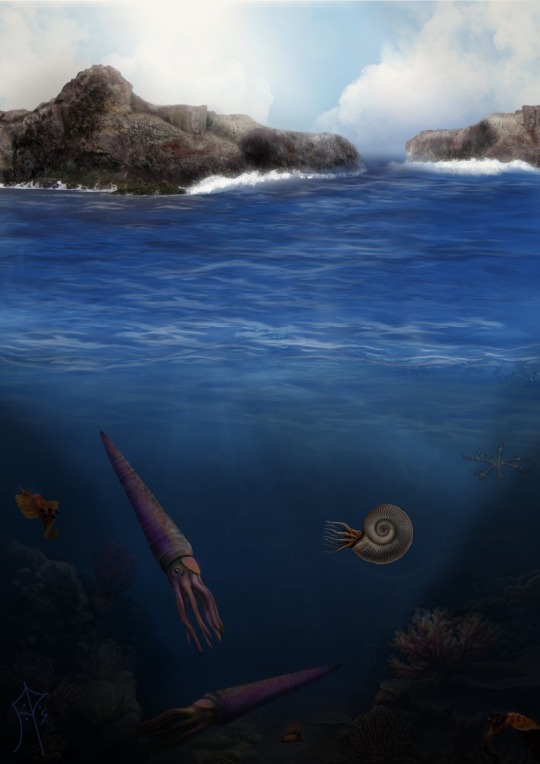
Biodiversity expands! | A biodiversidade se expande!
🇬🇧
The Ordovician Period is the second geological period of the Paleozoic Era, spanning from approximately 485.4 to 443.8 million years ago. It follows the Cambrian Period and precedes the Silurian Period.
During the Ordovician, Earth's landmasses were still clustered together in a supercontinent called Gondwana. The continents were located closer to the South Pole, and much of the Earth's surface was covered by a vast ocean known as the Iapetus Ocean. The climate during this period was relatively stable and warmer than the preceding Cambrian, with moderate temperatures and a generally shallow sea level.
It was a time of significant evolutionary diversification, marking the rise of various marine life forms. The seas were populated by a diverse array of invertebrates, including trilobites, brachiopods, mollusks, and echinoderms. Trilobites, in particular, were highly successful and abundant during this period. Early jawless fish, such as the ostracoderms, began to appear in the oceans, representing a crucial step in the evolution of vertebrates. However, these early fish were still quite primitive compared to later fish that would dominate the seas in subsequent periods.
The continents were gradually drifting, contributing to changes in oceanic circulation patterns and climate. By the end of the period, Gondwana began to experience fragmentation, marking the initial steps toward the eventual formation of different landmasses. These continental movements had profound implications for marine life and ecosystems.
The Ordovician-Silurian extinction event primarily affected marine life, and the impact on terrestrial environments and plants is not as well-documented as it is for marine organisms. During the Ordovician, land was sparsely populated by simple plants, and more complex terrestrial ecosystems would evolve in the subsequent periods.
🇧🇷
O Período Ordoviciano é o segundo período geológico da Era Paleozoica, abrangendo aproximadamente de 485,4 a 443,8 milhões de anos atrás. Ele sucede o Período Cambriano e antecede o Período Siluriano.
Durante o Ordoviciano, os continentes da Terra ainda estavam agrupados em um supercontinente chamado Gondwana. Os continentes estavam localizados mais próximos ao Polo Sul, e grande parte da superfície terrestre estava coberta por um vasto oceano conhecido como Oceano Iapetus. O clima durante esse período era relativamente estável e mais quente do que o Cambriano anterior, com temperaturas moderadas e um nível do mar geralmente raso.
Foi um período de significativa diversificação evolutiva, marcando o surgimento de várias formas de vida marinhas. Os mares eram habitados por uma variedade de invertebrados, incluindo trilobitas, braquiópodes, moluscos e equinodermos. Os trilobitas, em particular, foram altamente bem-sucedidos e abundantes durante esse período. Peixes primitivos sem mandíbula, como os ostracodermas, começaram a aparecer nos oceanos, representando um passo crucial na evolução dos vertebrados. No entanto, esses primeiros peixes ainda eram bastante primitivos em comparação com os peixes posteriores que dominariam os mares nos períodos subsequentes.
Os continentes estavam gradualmente se movendo, contribuindo para mudanças nos padrões de circulação oceânica e no clima. No final do período, Gondwana começou a se fragmentar, marcando os passos iniciais em direção à eventual formação de diferentes massas terrestres. Esses movimentos continentais tiveram profundas implicações para a vida marinha e os ecossistemas.
O evento de extinção Ordoviciano-Siluriano afetou principalmente a vida marinha, e o impacto em ambientes terrestres e plantas não está tão bem documentado quanto para os organismos marinhos. Durante o Ordoviciano, a terra era escassamente povoada por plantas simples, e ecossistemas terrestres mais complexos evoluiriam nos períodos subsequentes.
#science#paleontology#paleobotany#universe#digital painting#geology#biology#earth#space#artwork#paleoart#ocean
18 notes
·
View notes
Text

Some select fauna of the Cambrian aged Kinzers Formation, a middle Cambrian Lagerstatte similar to the Burgess Shale located in central Pennsylvania.
Wanneria walcottona, an Olenelloid trilobite
Hazelia walcotti, a demisponge, the only Cambrian sponge known in North America
Pelagia exigua, a small chetae-bearing gastropod
Camptostroma roddyi, a basal echinoderm
Odaria sp, a pelagic bivalved arthropod
An early chordate assigned to Metaspriggina sp
Leniscaris, a radiodont formerly assigned as Anomalocaris pennsylvannica
#artists on tumblr#paleoblr#paleoart#paleomedia#traditional drawing#paleozoic#cambrian#cambrian explosion#anomalocaris#trilobite
10 notes
·
View notes
Text
More "holiday" music -- for biology lovers and nerds:
An a cappella version of the "Hallelujah" Chorus -- with the lyrics changed to celebrate the entire Animal Kingdom (Lyrics in the video, and this post. Eye contact. 3 minutes, 45 seconds. Proper closed captions in Galician, auto-generated captions in Spanish):
youtube
Lyrics:
Animalia! (x10)
Our cells are phospholipid membranous Animalia (x4) But have no form-restrictive containers Animalia (x4) Our high motility is what shapes us For heterotrophy as predators Chordata, annelids and ctenophores Animalia!
The opisthokonta clade Has become The kingdoms of fungi And animals And animals
In the domain of eukaryota ATP made inside mitochondria But we contain no plastids like chloroplasts With blastulae as diplo- or triploblasts
Kingdom of Mollusca Tardigrada Arthropoda Chordata:
The phylum of Larvacia Agnatha Amphibia And Mammalia:
Classis of Rodentia Cetacea Carnivora Primates:
The order of Lemuridae Tarsiidae Atelidae Hominidae:
Family of Gorilla and Pongo Chimpanzee And homo:
The genus of Homo sapiens sapiens
(But we all came from before the Cambrian)
But we all came But we all came But we all came But we all came
From a concestor in the Precambrian
Protostomes (And deuter- ostomia) With desmosomes (Gap junctions, tight junctions) And microtubules nucleated by centrosomes
Coelomates with hollow cores Gastrulate from blastopores And we chordates have tails and gill slits and notochords
Echinoderms (Platyzoa, Nematoda) And Arthropods (Porifera and Cnidaria) Animalia (x4)
ANIMALIA!
#music#a cappella#biology#the Animal Kingdom#Christmas Season music#(even though this was originally composed for Easter)#eye contact#open captions#Youtube
4 notes
·
View notes
Text
Top to bottom, left to right:
Some Acanthodian, judging from the numerous spiky fins, probably Ptomacanthus (Devonian)
Hallucigenia (probably related to Arthropods, Cambrian)
Cothurnocystis (basal Echinoderm, Ordovician)
Opabinia (stem-Arthropod, Cambrian)
Boreaspis (jawless fish, Devonian)
Vetulicola (a weird stem-Chordate, Cambrian)
Possibly Waptia (a stem-Crustacean, Cambrian)
Aegirocassis (stem-Arthropod related to Anomalocaris, Ordovician)
An orthocone Nautiloid, possibly Orthoceras (Ordovician)
Amiskwia (stem-arrow worm, Cambrian)
Probably Diplocaulus (amphibian, Carboniferous-Permian)
Tullimonstrum (either a vertebrate or not a vertebrate, Carboniferous)
Haikouichthys or some other basal Vertebrate (Cambrian)

paleozoic menagerie
10K notes
·
View notes
Text
May Readings
Media Articles and Blog Posts (Not Everything, Just the Interesting Ones):
Arizona's Petrified Forest is Changing What We Know About the Dawn of the Dinosaurs by Shaena Montanari
Battling a Hungry Beetle, This Mohawk Community Hopes to Keep Its Trees -- and Traditions -- Alive by Nicole Dainty, Hannah Daramola, Madison Eldridge, and Nadja Radakovic
Building Britain's Borders by Marc Di Tommasi
Call of the Liar by Carly Cassella
Captive-Bred Axolotls Were Successfully Introduced to the Wild. Can This Work for Other Species? by Kiley Price
Could This Arizona Ranch Be a Model for Southwest Farmers? by Samuel Gilbert
Feather Forensics Offers a Way to Root Out Poachers by Jude Coleman
The First Volcanic Eruption to be Photographed? by David Pyle
Fossil Folklore: Echinoderms by Paul D. Taylor
Fossils Reveal Enormous, Crocodile-Like Reptiles Survived for Millions of Years Longer Than Previously Thought by Lillian Ali
How Can You Tell if Soil is Healthy? Just Listen to It by Ayurella Horn-Muller
In the Netherlands, Anyone Can Turn a Slice of Sidewalk into a Garden by Klaus Sieg
It Used to Spell Death and Destruction for Ecosystems. Now, It Can Be the Key to Saving Them by Anna Gibbs
Martin Crusius' Armchair Voyage by Richard Calis
Mobile Home by Steven Bedard
The Otsu Incident by Mathew Lyons
Pulled From the Deep by Clare Fieseler
The Record of Natural Disasters on the Coinage of Imperial Rome by David R. Sear
Russians Recover Lost Ice Station by Theodore Shabad
Scientists Identified the Oldest Star Chart in Existence by Elizabeth Rayne
Scientists Think They Can Save the 'Asian Unicorn' -- If It's Not Already Extinct by Emma Frederickson
Slow-Speed Chase by Krista Langlois
Smuggling Under the Cover of Plague by Dabeoc Stanley
The Sounds and Songs of Iceland's Melting Landscape by Karen McHugh
Unearthing the Mysteries of Hawai'i's Ancient Agriculture by Sarah Lohman
Walled Off by Phoebe Weston
We Need to Remember Problems We Solved by Laura Helmuth
Whale Sharks' Low-Oxygen Advantage by Claudia Geib
What a Whale Does Not See by Marina Wang
What Deep Cuts to NOAA Mean for U.S. Fisheries by Meg Wilcox
Why Most No-Till Agriculture Is Not Actually Regenerative by Nate Powell-Palm
Wildlife, Not Livestock: Why the Eastern Shoshone in Wyoming Are Reclassifying Buffalo by Taylar Dawn Stagner
World's Earliest Depiction of Volcanic Eruption by Kathleen Micham
World's Smallest Volcano Discovered in Colombia by Erik Klemetti
Scholarly and Scientific Articles:
"Ancient Fossil Discoveries and Interpretations" by Adrienne Mayor
"Bioelectrical Synchronization of Picea abies During a Solar Eclipse" by Alessandro Chiolerio, Monica Gagliano, Silvio Pilia et al
"Conditions of Life at Great Depths in the Ocean" by August Krogh
"Early History of the Great Red Spot on Jupiter" by W. F. Denning
"An Ichthyosaur Carcass-Fall Community from the Posidonia Shale (Toarcian) of Germany" by Daniel G. Dick
"Lightning Teeth and Ponari Sweat: Folk Theories and Magical Uses of Prehistoric Stone Axes (and Adzes) in Island Southeast Asia and the Origin of Thunderstone Beliefs" by Adam Brumm
"Movie Footage of the Activity of Parícutin Volcano, Michoacán, Mexico, 1945-1952" by Carl Fries, Jr., Kenneth Segerstrom, Robert I. Tilling, et al
"The Origin of Jupiter's Great Red Spot" by Agustín Sánchez-Lavega, Enrique García-Melendo, Jon Legarreta et al
"A Phenomenon Discovered While Imaging Dolphin Echolocation" by Jack Kassewitz and Michael Hyson
"Radiocarbon and DNA Evidence for a Pre-Columbian Introduction of Polynesian Chickens to Chile" by Alice A. Storey, José Miguel Ramírez, Daniel Quiroz, et al
"Reconstructing Tropical Arctic: Greenland's Late Triassic Past" by Jennifer McElwain, Marlene Hill Donnelly, and Ian Glasspool
"The Selective Geography of Volcanism in Oral Traditions" by Leigh Franks, Patrick D. Nunn, Adrian McCallum
"The Significance of Anomalocaris and Other Radiodonta for Understanding Paleoecology and Evolution During the Cambrian Explosion" by Gaëtan J.-M. Potin and Allison C. Daley
"Whale-Fall Ecosystems: Recent Insights into Ecology, Paleoecology, and Evolution" by Craig R. Smith, Adrian G. Glover, Tina Treude et al
Short Stories
"Nightfall" by Isaac Asimov
0 notes
Text
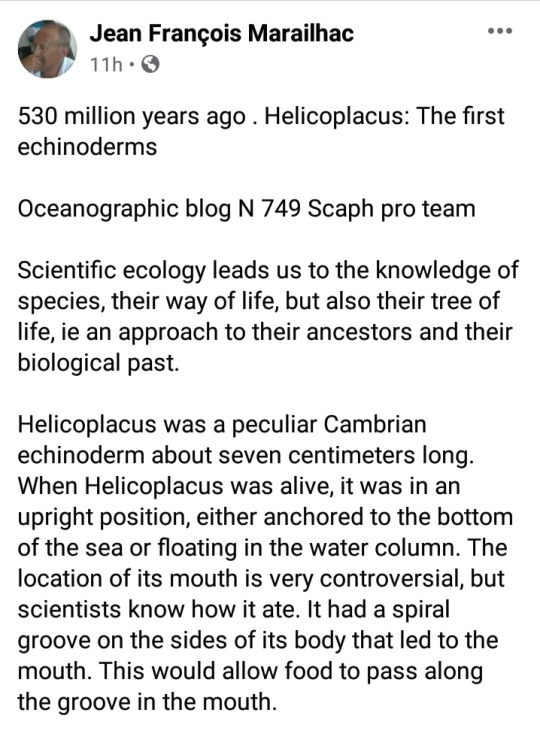

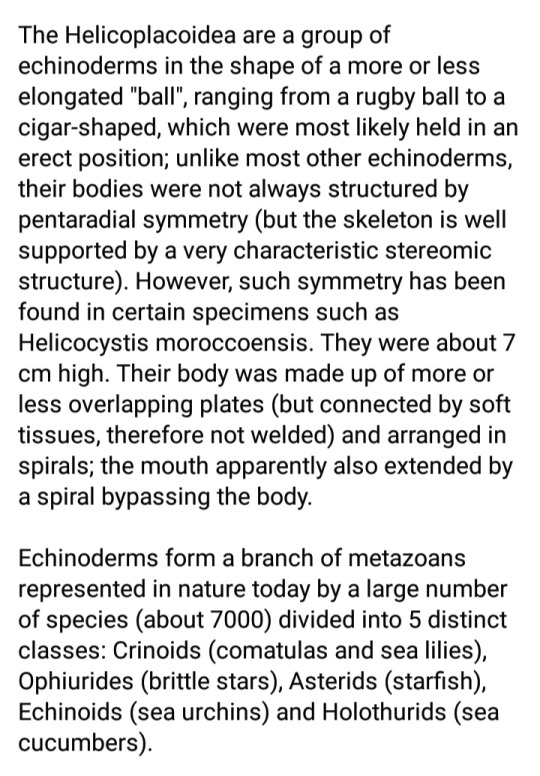


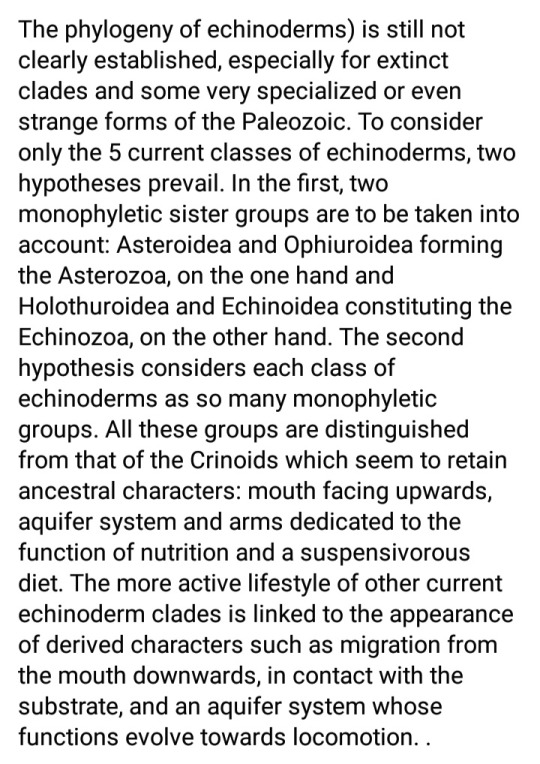

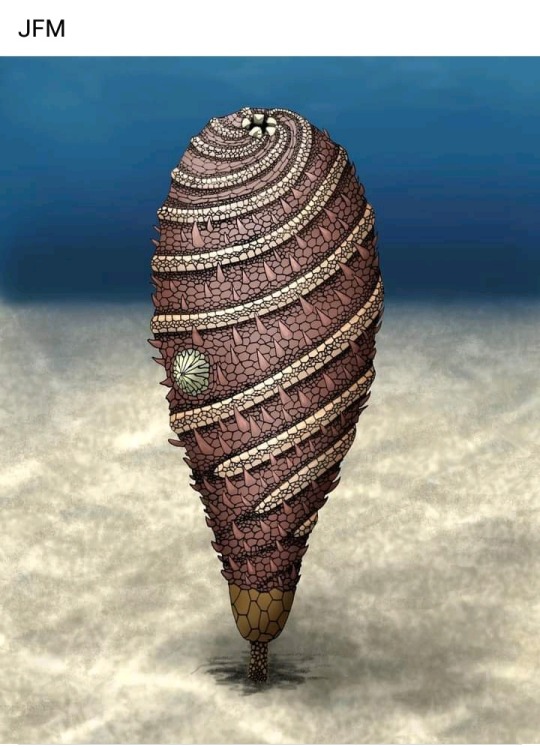
1st Echinoderms, Helicoplacus "spiral plate"
#marinebiology#echinoderms#cambrian echinoderms#the first echinoderms#scientific ecology#helicoplacoidea#spiral plate
3 notes
·
View notes
Text
Monday Musings: Why was the Cambrian Explosion possible?
Hello everyone! Did you miss me? Field season was wild but now I'm back and ready to talk more about rocks and fossils!
The Cambrian Explosion happened when marine life radiated rapidly into most of the basic body forms that we observe in modern groups today.

What made the Cambrian Period the ideal time and place for such an evolutionary burst? To get the answers, we need to go back in time just before the Paleozoic Era began.

Welcome to the Ediacaran Period, 600 million years ago. All of the continents were joined together to the form the supercontinent...Pannotia. You thought I was going to say Pangea, didn't you?

Pangea came much later. Pannotia sat on the south pole and it had a pretty massive ice cap on it. Of course, that was nothing compared to the snowball Earth o the previous period. The oceans were much cooler in this time and just like cold oceans today, it could have been the ideal breeding ground for plankton as cold water brings nutrients to the surface.
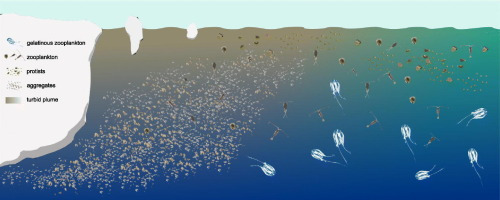
As the Ediacaran came to an end and the Cambrian began, the ice cap melted, the seas warmed up and the Pannotia began to break up.
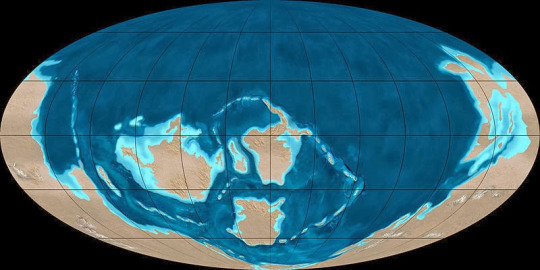
One large continent, Gondwana, stayed at the south pole but several island continents moved toward the equator. The placements of the continents was critical to the evolutionary explosion.
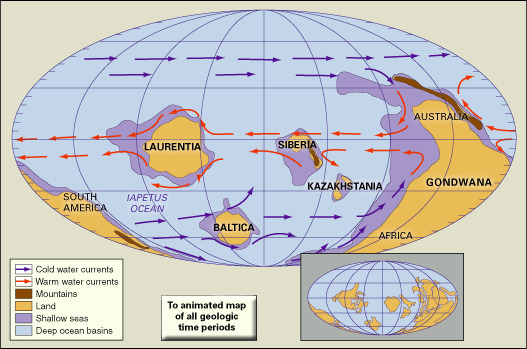
Ocean currents have a huge impact on climate. If we look at this map of the Cambrian world and its ocean currents, you can see the cold currents at the mid-latitudes and poles heading to the equator where they warm up and go back to the poles to cool down.

Now, if I plug in all our important Cambrian fossil sites you'll see that a vast majority fall on or very near the equator. An increase in warm ocean water and a rise in oxygen brought on by melting ice were probably two big parts in the rise of living organisms. Cold water brings nutrients up and is circulated by ocean currents. Warm water facilitates the production of carbonates like limestone and calcite for living things like echinoderms and arthropods.
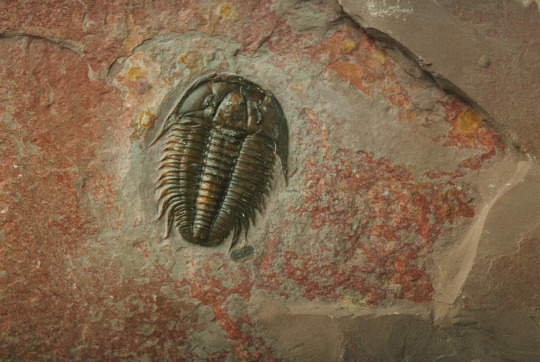
#paleontology#fossils#geology#mineralogy#deep time#cambrian period#cambrian explosion#paleoclimate#ocean currents
25 notes
·
View notes
Text
Round 2 - Arthropoda - Thecostraca




(Sources - 1, 2, 3, 4)
Thecostraca is is a class of crustaceans, many of which have planktonic larvae which become sessile or parasitic as adults. The most well-known group are the Barnacles (subclass Cirripedia), but Thecostraca also includes the parasitic Ascothoracida, and the mysterious Facetotecta.
Facetotecta, comprising only the genus Hansenocaris, are known only from their larvae (image 3) and adults have yet to be recognized, though some scientists believe they may actually be larval tantulocaridans.
Ascothoracidans are parasites of echinoderms and cnidarians. Most genera are meso and endoparasitic (living inside the host) while some are ectoparasitic (living on the outside of the host). They are similar in anatomy to copepods, with six pairs of legs, an abdomen with four segments, a telson, and a bivalved carapace. They feed on their host via piercing and sucking mouthparts, and some more advanced species also absorb nutrients through the carapace. They are sexually dimorphic, in many cases so much so that the smaller males will live inside the larger female’s mantle cavity.
Barnacles (subclass Cirripedia) are more well-known than other Thecostracans. Adult barnacles are sessile filter feeders, except for the infraclass Rhizocephala, which are parasites of other crustaceans. Barnacles attach themselves to a surface as adults, be that a rock, the shell of a mollusc, a ship, or a large animal such as a whale. They come in two common forms: acorn barnacles which grow their shells directly on a surface (image 4) and goose barnacles which attach themselves via a stalk (image 1). Barnacles have a carapace made of six calcareous plates, with a lid made of four more plates. They attach themselves to the substrate by means of a cement gland at the base of their antennae. Eight pairs of thoracic limbs, called cirri, extend from the carapace to filter plankton from the water and bring it towards the mouth. The hairs on these limbs are very sensitive to touch, and help the barnacle sense the world around them. They also have three simple eyes (ocelli) which can sense changes in light, allowing them to close their plates quickly if a shadow is detected.
Thecostracans have nauplius larvae, characterised by a head with antennules, antennae, mandables, and a single eye, three pairs of limbs, a carapace, and a telson. Barnacle larvae are brooded by the parent until their first moult, after which they are released to swim freely using setae.
The oldest known thecostracan fossil is dated from the Middle Cambrian. Traces of the parasitic forms have been dated from the Cretaceous.

Propaganda under the cut:
Barnacles have the longest penis (relative to body size) of any living animal. You can see it in action in the above gif and in this video.
Most barnacles are not parasitic (other than hitching a ride) and usually do no harm to the large animals they attach to. An overload of barnacles tends to be a symptom of an underlying issue, such as the animal being unable to shed its skin. Non-professionals scraping or pulling barnacles off of whales and turtles often does more harm than good for the affected animal!
12th-18th Century Europeans thought that Brants and Barnacle Geese emerged, fully formed, from Goose Barnacles. Gerald of Wales claimed to have seen the birds hanging down from pieces of timber, William Turner accepted the theory, and John Gerard claimed to have seen the birds emerging from their shells. In County Kerry, until relatively recently, Catholics abstaining from meat during Lent could still eat this bird because it was considered a fish.
As filter-feeders, barnacles play an important role in the ecosystem: not only for transferring nutrients up the food chain, but also for keeping the water clean.
When a barnacle chooses its home, it produces a biological glue made of six different proteins. While the glue hardens, it accumulates limestone salts, turning into a concrete-like shell. Barnacle glue is six times stronger than any manmade glue. Scientists are trying to replicate this glue for use in the fields of engineering, construction and medicine, where it can be used as a biological sealant during or post-surgery.
#i could add SO MUCH more but I am trying to make these descriptions shorter both for your sake and for mine#looking forward to narrowing these down to smaller groups in later rounds where I won’t have to write So Dang Much#anyway crabs are coming in the next one#round 2#animal polls#arthropoda#thecostraca
37 notes
·
View notes
Photo
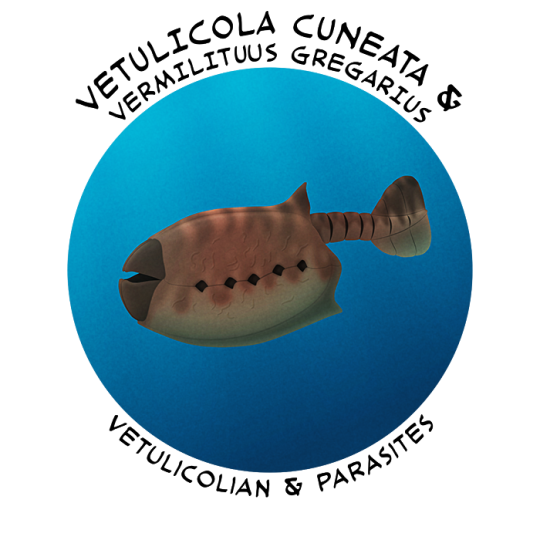
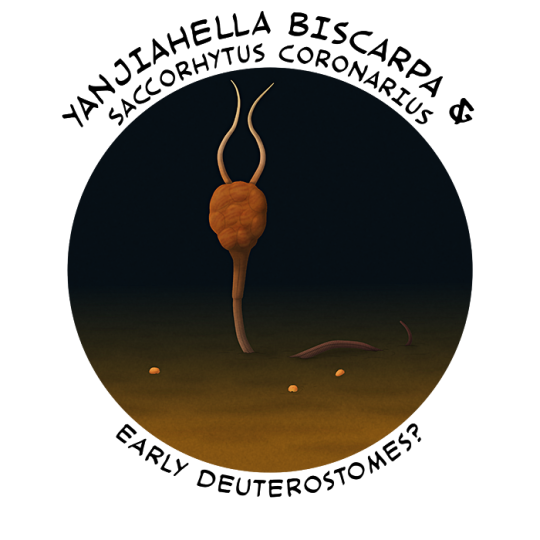
Cambrian Explosion Month #17: Phylum(?) Vetulicolia & Other Early Deuterostome Weirdos
Vetulicolians were a group of odd Cambrian animals known from between about 520 and 505 million years ago. The front half of their bodies were large and streamlined, with a prominent mouth, no eyes, and five pairs of openings that seem to have been gills, with some species having a rigid exoskeleton-like carapace. Their back half was slender, segmented, and flexible, and functioned as a tail for swimming, giving them an overall appearance like alien tadpoles.
Their evolutionary affinities have been problematic for a long time, but evidence of a notochord in some specimens suggest they were probably related to the chordates in some way. Sometimes they're considered to represent their own phylum, but they might also be stem-chordates or stem-tunicates.
Vetulicola cuneata is known from the Chinese Chengjiang fossil deposits (~518 million years ago). Around 7cm long (2.75"), it had a prominent stabilizing keel on its underside and a dorsal fin-like structure on its back, suggesting it was an active swimming animal.
It was probably a filter-feeder, but large amounts of sediment found preserved inside its gut may indicate that it was a detritivore, scooping up mouthfuls of organic matter from the seafloor
A few specimens are infested by a small tubeworm-like creature, Vermilituus gregarius. These animals appear to have lived in the voluminous front body cavity of V. cuneata, embedded inside its carapace, and may have been parasitic – possibly "stealing" food particles their host was filtering. Some individuals were heavily infested, carrying as many as 88 of these worms, which probably caused a significant biofouling effect on their hydrodynamics.
The stalked animal Cotyledion tyloides has also sometimes been found attached to the tip of V. cuneata's tail, probably opportunistically filter-feeding on its poop.
———
Yanjiahella biscarpa was an early deuterostome, but it's hard to say anything more definite about it. Known from the Chinese Yanjiahe Formation, it dates to the very start of the Cambrian about 541-535 million years ago, and has been tentatively classified as a very early echinoderm – which would make it 15-20 million years older than any other definite echinoderm fossils.
But its anatomy is ambiguous, with some hemichordate-like features and no evidence of echinoderms' characteristic calcite skeleton. It's not clear where it actually belongs in the deuterostome family tree – it could be an echinoderm, but it could also be a hemichordate, an early ambulacrarian, or part of a separate early deuterostome stem lineage.
Up to 5cm long (2"), it had a muscular stalk-like appendage, an irregularly plated body, and two tentacle-like feeding appendages. If it was an echinoderm, it would represent a very early bilaterally-symmetric form, with later bilateral forms like Ctenoimbricata losing the stalk and feeding appendages before other echinoderms re-evolved similar structures later on.
———
Living at the same time as Yanjiahella, in a nearby region of China, a tiny animal called Saccorhytus coronarius may have been another weird early deuterostome.
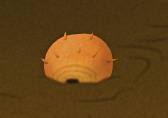
It had a globular body, only about 1.3mm long (0.05"), with several small cone-like or spine-like structures and a prominent mouth surrounded by nodular ridges, making it look like a tiny screaming potato. It didn't seem to have an anus – but it's not clear if it just wasn't visible in the minuscule fossils, if it represents an ancestral state inherited from earlier bilaterians, or if it was a secondarily lost feature like in modern brittle stars.
It's been interpreted as being closely related to the vetulicolians, but there's also a possibility it wasn't a deuterostome at all. Another analysis has found it to instead be an early ecdysozoan, closer related to the scalidophorans – although this study hasn't been properly peer-reviewed yet, so it's unclear how accurate it is.
———
Nix Illustration | Tumblr | Pillowfort | Twitter | Patreon
#science illustration#paleontology#paleoart#palaeoblr#cambrian explosion 2021#vetulicolia#vetulicola#chordata#yanjiahella#echinoderm#saccorhytus#deuterostome#vermilituus#bilateria#eumetazoa#animalia#art#parasite#tiny screaming potato
118 notes
·
View notes
Text
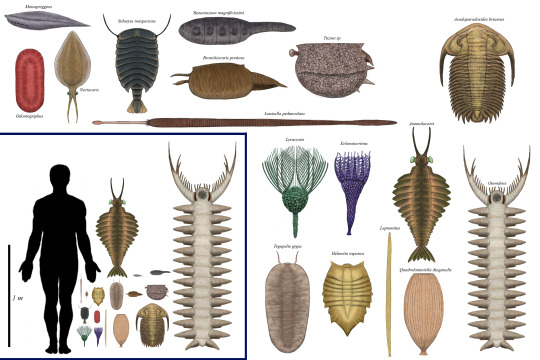
As many know well the Cambrian is the beginning of our world’s biodiversity, is an advance follow up of the ediacaran flourish of life under the ocean, the major period of life diversification with the explosion and rise of the many major clades of animals that would establish for the next 500 million years, such as mollusks, annelids, arthropods, chordates, etc. as well alongside them some other very bizarre clades that arose and at the same time perished in that span which couldn’t leave any descendant after. The marine life grew up and became more from the pacific sessile or slow filter feeders or detritivorous ediacarans stuck in the sand, radiating into a crazy mosaic of different creatures nothing like anything that appeared before and establishing the bases for the dominant clades today, with different shapes, number of legs, numbers and shape of eyes, segments, and most important… in different sizes, mostly small, but some larger than the average…
For this chart I wanted to do something more than just pick the few largest animals of period which excess the meter long (which could have been just 2 specie), so I tried to see specimen size from all other clades known from the period, giving more variety of what some of the biggest animals were, even if they weren’t gigantic like most of actual fauna, of course with this I have to be a bit selective as not many clades really became enough large, at least in this chart the species I will expose are larger than 10 cm and noticeable enough, so even the largest animals of some clades here will be out for being very, very small…
The world in this point was pretty much the world of the Panarthropods, the major clade that includes all known Arthropoda and stem-arthropod, and there is no doubt that the Lobopodians were one of the major faunistic Panarthropods in many pelagic and benthonic niches, becoming some species iconic for its many bizarre forms and some others for their extraordinary sized, specially the Anomalocarids such as the iconic genus Anomalocaris��with known specimens reaching lengths of around 60 cm to a meter long making it one of the biggest predators of the ocean at the period and being the first apex predator of history; there is also a tentative competitor for the position as the biggest lobopodians, as well the biggest animal of the period, the species Omnidens amplus (originally classified as a worm), only know by a preserved set of mouthparts, which scaled up with some relatives like the benthonic dweller Pambdelurion gives a size estimation of 1.5 to 2 meters long, but for the lack of a complete body makes difficult a properly size estimation.
Alongside the Lobopodians were also the myriad species of Arthropods, most of them were in the genesis of the clades that could come up millions of years after, just like Crustaceans, Chelicerata or Mandibulata, but in this point on time these weren’t yet a thing like they would be in next periods, instead the diversity of these was formed by other clades, specially a lot of stem-group outside euarthropods and still unknown to link clades as well others euarthropods unrelated to the major clades mentioned first; the pelagic Tuzoiid Tuzoia sp. was able to reach 18 cm long, the benthonic Sidneyia inexpectans with specimens reaching up 16 cm long and the genus Branchiocaris pretiosa which reached up sizes around 15 cm long, not giants but still pretty large among their groups.
The Trilobites are one if not the major clade of arthropods for excellence during the Paleozoic, with different variety of species, being the Cambrian the pinnacle of its population clades with more than 60 families, most of these were around the lengths of less than 10 cm and often were the prey of bigger animals, but in some others places they were able to reach a very extraordinary size, being one of the biggest species known the redlichiide Acadoparadoxides briaerus from morocco, with specimens reaching up 45 cm long. Apart of trilobites, there were some other relatives which belongs to a major clade known as “Trilobitomorpha” which resemble them in certain anatomical features, but they weren’t true trilobites, such as the Helmetiid Helmetia expansa, a very large soft-bodied looking arthropod of around 27 cm long is one of the largest non-anomalocarids arthropods of burgers shell, and the Tegopeltidae Tegopelte gigas with a size of 19 cm.
The Archaeopriapulida (stem-priapulids) were other of the predatory benthonic animals of the Cambrian landscape, pretty much found burrowing in the sand and mud and protruding from their places, exposing a large proboscis they were mostly ambush hunters. The most well known is probably Ottoia for the common of its specimens, but these often doesn’t pass the length of 8 to 15 cm, but others were bigger that this one, a good example is the species Louisella pedunculata, which the largest specimen reached a size of 30 cm long with the proboscis extended.
One odd group among the Cambrian biota was the Vetulicolians, an enigmatic clade probably related to deuterostomes. These were weird arthropod-looking creatures that shown adaptations for pelagic lifestyle and mostly being filter feeders, many of these tended to be average lengths less than 10 cm, but Yuyuanozoon magnificissimi from comes to be the largest species known, with a length of 20.2 cm
The Chordates diversity during the Cambrian was formed by a small group of vermin agnatha forms, mostly swimming filter feeding of small size of few centimeters, the largest of these was Metaspriggina with specimens reaching up to 10 cm long which wasn’t that large size compared to many Cambrian lifeforms, was still an outstanding length compared to other of the chordates of the period.
Echinoderms were in their early genesis of its diversification with some unique morphology, so bizarre and alien compared to our actual species, as well there were others similar or very close in many aspect to actual ones, although most were very minuscule, some of the few macroscopic forms included, Lyracystis which is the largest eocrinoid with specimens reaching up sizes to 21 cm tall being half of it the arms.
Lophotrochozoa flourished during this period, evolving into the important clades including the very common brachiopods, the basic annelids and the Mollusks, although there were some species that could be classified as the last ancestors or stem-relatives of such clades, they don’t belong to these clades but they are coming to the roots of these, including Odontogriphus which specimens were able to reach up sizes around 12 cm long. Mollusks started their slow path into diversification with early small shelled varieties, most of them minuscule and don’t reaching up few centimeters of length, although few reached some considerable size for the average, such as the pelagic Nectocaris pteryx, the enigmatic cephalopod-like mollusk (?) with specimens reaching up sizes of 7 cm long.
Cnidaria are among the oldest animals on earth which during the cambrian expanded though the warm oceans either as jellyfish or small coral-like forms that could spread in the next periods, among some of these early species there was Echmatocrinus which is a pretty robust form with a height of 18 cm tall.
Sponges were one of the major reef builders of the Cambrian, forming alongside other sessile lifeforms extensive biomes which thrived in the warm swallow oceans. Some of the biggest sponges found so far belong to the species Quadrolaminiella diagonalis which were barrel shaped sponge from the Chengjiang Fauna, with a height of 20 cm and a diameter of around 12 cm. Another species was Leptomitus, a very tall but thin kind of sponge from Burgers Shale, with specimens reaching up heights around 36.4 cm, but with a diameter less than a centimeter long.
A minor stuff worth to mention, other of the bizarre benthonic reef builders that dominated the Cambrian seabed were the archaeocyathids, a group formed by small conical shaped forms with some brachiating forms, similar in many ways to sponges except in inner structure, some of these often reached sizes of around 9 to 10 cm tall and some centimeters in diameter, but according to some mentions in websites and papers some were able to reach up even very larger sizes, with giant specimens reaching around 60 cm, but I wasn’t able upon this date to locate these very big forms so I couldn’t add them (either these are exaggerated estimations from fragmentary individuals or actually those were hinted from other fossil sponges)
References
-Briggs, D. E. (1972). Anomalocaris, the largest known Cambrian arthropod. Palaeontology, 22(3), 631-664.
-Vinther, J., Porras, L., Young, F. J., Budd, G. E., & Edgecombe, G. D. (2016). The mouth apparatus of the Cambrian gilled lobopodian Pambdelurion whittingtoni. Palaeontology, 59(6), 841-849.
- Xianguang, H., Bergström, J., & Jie, Y. (2006). Distinguishing anomalocaridids from arthropods and priapulids. Geological Journal, 41(3‐4), 259-269.
-Whittington, H. B. (1985). Tegopelte gigas, a second soft-bodied trilobite from the Burgess Shale, Middle Cambrian, British Columbia. Journal of Paleontology, 1251-1274.
-Bruton, D. L. (1981). The arthropod Sidneyia inexpectans, Middle Cambrian, Burgess Shale, British Columbia. Philosophical Transactions of the Royal Society of London. B, Biological Sciences, 295(1079), 619-653.
-Vannier, J., Caron, J. B., Yuan, J. L., Briggs, D. E., Collins, D., Zhao, Y. L., & Zhu, M. Y. (2007). Tuzoia: morphology and lifestyle of a large bivalved arthropod of the Cambrian seas. Journal of Paleontology, 81(3), 445-471.
- Rudkin, D. M., Young, G. A., Elias, R. J., & Dobrzanski, E. P. (2003). The world's biggest trilobite—Isotelus rex new species from the Upper Ordovician of northern Manitoba, Canada. Journal of Paleontology, 77(1), 99-112.
- Daley, A. C., Antcliffe, J. B., Drage, H. B., & Pates, S. (2018). Early fossil record of Euarthropoda and the Cambrian Explosion. Proceedings of the National Academy of Sciences, 115(21), 5323-5331.
- Aria, C., & Caron, J.-B. (2017). Burgess Shale fossils illustrate the origin of the mandibulate body plan. Nature, 545(7652), 89–92.
-Walcott, C. D. (1911). Cambrian Geology and Paleontology II: No. 5--Middle Cambrian Annelids.
-Morris, S. C., & Caron, J. B. (2014). A primitive fish from the Cambrian of North America. Nature, 512(7515), 419.
-Sprinkle, J., & Collins, D. (2006). New eocrinoids from the Burgess Shale, southern British Columbia, Canada, and the Spence Shale, northern Utah, USA. Canadian Journal of Earth Sciences, 43(3), 303-322.
- Sprinkle, J., & Collins, D. (1998). Revision of Echmatocrinus from the middle cambrian burgess shale of British Columbia. Lethaia, 31(4), 269-282.
- Caron, J. B., Scheltema, A., Schander, C., & Rudkin, D. (2006). A soft-bodied mollusc with radula from the Middle Cambrian Burgess Shale. Nature, 442(7099), 159.
- Walcott, C. D. (1917). Middle Cambrian Spongiae. Smithsonian Miscellaneous Collections.
- Legg, D. A., Sutton, M. D., & Edgecombe, G. D. (2013). Arthropod fossil data increase congruence of morphological and molecular phylogenies. Nature communications, 4, 2485.
- Wu, W., Zhu, M., & Steiner, M. (2014). Composition and tiering of the Cambrian sponge communities. Palaeogeography, Palaeoclimatology, Palaeoecology, 398, 86-96.
#Paleoart#paleontology#History Size Chart#Cambrian#Burgess Shale#Anomalocaris#Trilobite#Arthropoda#Echinoderms#Lobopodia
141 notes
·
View notes
Photo
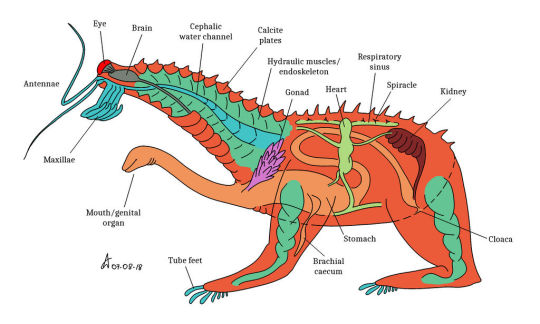
Hypothetical land animal descended from a starfish.
Original page on my DeviantArt here (drawn in 2018, when I should have been working on my master thesis instead)
It's well known that echinoderms descend from bilateral ancestors [i.e. with a left/right symmetry, like vertebrates], such as the Cambrian Ctenoimbricata, and that they adopted a secondary radial symmetry as an adaptation to an increasingly sessile, filter-feeding lifestyle like that we see in sea lilies today. In fact, later Paleozoic echinoderms seem to run the gamut from fully asymmetric (Cothurnocystis) to three-sided (Helicoplacus) to five-sided (Gogia), The reduction of musculature in favor of connective- and vascular system-based movement might have the same origin. (On this argument, see Zamora et al., 2012 and Zamora & Rahman, 2015.) Interestingly, some modern echinoderms seem to be going the opposite way. Some sea cucumbers have retaken an active, and even pelagic, lifestyle, and their bodyplan is taking a more bilateral shape. Brittle stars, which are surprisingly active animals, have redeveloped their musculature and greatly reduced the vascular tube feet. So. What if an echinoderm, say a common starfish, were to evolve into a motile, bilateral, maybe even land-based animal? Now, as great as echinoderms are, they do have significant handicaps in this sense. Their vascular system, from which they depend for movement, respiration, and metabolite distribution, is open to the outside (seawater is filtered through a porous plaque called madreporite). They have no reliable system of osmoregulation, which means they can't survive without salt water. Let's be realistic, if in half a billion year echinoderms have never produced (as far as we know) so much as a freshwate species, let alone a terrestrial one, I don't think there's much hope of it happening in the future. But, just for the fun of it, let's imagine it happens anyway. A starfish somehow manages to close off its water vascular system (which is, after all, a compartment of the coelom), keeping it around only for mechanical purposes. Respiration is transferred to the body wall, which develops many small respiratory sacs; and circulation is full entrusted to the haemal system, a net of channels separate from the coelom. (In the case you need it, this is a pretty good diagram of starfish anatomy.) The hemal system develops a proper heart (rudiments of which already exist in starfish) and a kidney-like organ(s) to regulate the salinity of blood and the vascular fluid. Now our creature can live in fresh water. The water vascular system fills the larger coelom compartment and forms hydraulic muscles - connected sacs (each of which can be sealed off with a sphincter if it loses pressure) that can contract or relax thanks to walls of proper muscle. Once the body wall is flexible enough, this allows both and efficient control of movement, and mechanical support even out of the water! The creature adopts a very active lifestyle, which naturally favours a bilateral symmetry, because when you move in a consistent direction it's more efficient to place your sense organs, weapons, and mouth there (basically making a head), and not put them behind. There's no meaningful difference between left and right sides, though. Each arm of a starfish contains a nerve that runs along the ventral surface (better to pull that inside!) and ends in an "optic cushion", basically an eye. The distal tube feet allow to crudely manipulate objects. That's a good start for a head. A single eye can't see depth, but you can just do what birds (which can't look at an object with both eyes) do, and bob your head to infer distances from parallax. Of course the nerve cord will concentrate its neurons at the end, and form a crude brain. A problem: you can't put the mouth there, because the mouth of a starfish is at the center: it's the opening of the big central stomach that can be everted to swallow preys. Problem solved: pull a Snaiad and extend the stomach forward, basically as a muscular second head that exists only to feed. No, not only. Starfish have huge gonads that open between the arms to spray eggs and sperm into the water and hope for the best. Out of water, that's not an option. So let's say the gonads reorient their openings into the stomach. Now the feeding head is also a genital organ, and the land-starfish can impregnate each other with a kiss. (The female will probably just vomit the fertilized eggs, maybe in a convenient pond for a frog-style larval stage.) For respiration, say that the little cavities between the dorsal plates become hundreds of tiny lungs, each opening into a spiracle, that deliver oxygen to the haemal system. More specifically, soaking in the blood of a special haemal compartment (a "respiratory sinus"). The anterior tube feet, which will always be the first bodypart to contact something, have developed a hard cuticle that divides them in discrete segments, turning into two pairs of antennae and four of maxillae (insect-stile jaws, useful to fend off enemies and chew up food for the gastro-genital head). Similarly, independent tube feet have survived at the tip of the other four arms - which have not gained much complexity, beyond the new hydraulic musculature. In other species they may take the form of sharp claws or nimble fingers. And there you have it. A starfish from our seas turned into a barely recognizable ursine beast by a number of suspiciously convenient adaptations - not to mention a distinct lack of terrestrial competition and a generous reprieve from planetary sterilization courtesy of the Sun. An implant on a mostly empty alien planet, perhaps? Or simply evolution taking a radically different road somewhen around the Ordovician Extinction, maybe in a world in which this "vertebrate" thing didn't really work? Chissà.
@danbensen >_>
104 notes
·
View notes
Photo

Crinoids!
If you spend any time looking at carbonate rocks in the U.S. or Europe, and probably in other areas around the world, you’re likely to run into a lot of these critters. These are segments of crinoid stems, the remnants of a number of species that are nearly extinct today but once dominated the ocean floor environments.
Crinoids are animal species; echinoderms, the same phylum that today contains animals like starfish and sea urchins. Despite being animals, their behavior seems a lot like plants. Crinoids are filter-feeding organisms that lived on the ocean floor. They attach themselves to the ocean floor and grow long stalks upwards. Some crinoids could have been more than a meter tall on the ocean floor. They grew upwards until they stood above other species, allowing them to filter food out of the passing ocean waters.
Occasionally crinoids are found in-tact, with the full stalk still hooked together, but much more common is this type of fossil. These are segments of the stalk of the crinoid. The stalk is built up of many of these segments hooked together, all made out of calcium carbonate; the organism grew as a tower of these stem segments. When they die, the stems commonly break apart, dispersing dozens, if not hundreds of segments out into the nearby environment. Consequently, rocks from the age dominated by crinoids are often absolutely loaded with these segments.
These crinoids are about 165 million years old and come from the Wiltshire area in the United Kingdom. The lines that began evolving into the crinoids likely began during the Cambrian and similar species are represented within the Burgess Shale fauna. They dominated the seas of the Paleozoic from the Ordovician on, but most species nearly went extinct during the end-Permian mass extinction. Since then, crinoids have become much rarer in the ocean; only a single species is known from the early Triassic. These particular crinoids and the ones alive today are likely descendents of that single surviving species.
-JBB
Image credit: Wednesbury Museum & Art Gallery, shared under creative commons license http://www.flickr.com/photos/41006267@N06/5029090765/ http://geologymatters.org.uk/collections/getrecord/WEDSD_Geology_Temp_13/
Read more: http://www.ucmp.berkeley.edu/echinodermata/crinfoss.html http://www.oceanicresearch.org/education/wonders/echinoderm.html
#Crinoids#Geology#Cambrian#Evolution#Fossil#Fossilfriday#Crinoid stem#stalk#Segment#echinoderm#Ocean#the earth story
94 notes
·
View notes
Text

An article published in the journal "Current Biology" reports a study on exceptionally preserved Rotadiscus grandis fossils. A team of researchers led by Dr Imran Rahman of the Natural History Museum in London offered many new insights into these animals dating back to the Lower Cambrian period, about 518 million years ago. Previous studies had left a number of questions about their classification and lifestyle. The new study assigns them to the large Ambulacraria group, which includes the Echinoderms and Hemicordata phyla and is part of the superphylum Deuterostomia together with the phylum of Chordates. If this classification is correct, it indicates that certain characteristics of later animal species emerged independently several times.
12 notes
·
View notes